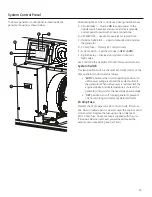
5
WarninG
Storage batteries give off explosive hydrogen gas
during recharging.
Slightest spark will ignite hydrogen and
cause explosion.
Battery electrolyte fluid contains acid and is
extremely caustic.
Contact with battery contents will cause severe chemical burns.
A battery presents a risk of electrical shock and high short
circuit current.
DO NOT dispose of battery in a fire. Recycle battery.
•
DO NOT allow any open flame, spark, heat, or lit cigarette during
•
and for several minutes after charging a battery.
DO NOT open or mutilate the battery.
•
Wear protective goggles, rubber apron, rubber boots and
•
rubber gloves.
Remove watches, rings, or other metal objects.
•
Use tools having insulated handles.
•
WarninG
Generator produces hazardous voltage.
Failure to properly ground generator can result in
electrocution.
Failure to isolate generator from power utility can result in
death or injury to electric utility workers due to backfeed of
electrical energy.
When using generator for backup power, notify utility company.
•
DO NOT touch bare wires or bare receptacles.
•
DO NOT use generator with electrical cords which are worn,
•
frayed, bare or otherwise damaged.
DO NOT handle generator or electrical cords while standing in
•
water, while barefoot, or while hands or feet are wet.
If you must work around a unit while it is operating, stand on an
•
insulated dry surface to reduce the risk of a shock hazard.
DO NOT allow unqualified persons or children to operate or
•
service generator.
In case of an accident caused by electrical shock, immediately
•
shut down the source of electrical power and contact the local
authorities.
avoid direct contact with the victim.
Despite the safe design of the residential generator, operating
•
this equipment imprudently, neglecting its maintenance or being
careless can cause possible injury or death.
Remain alert at all times while working on this equipment.
•
Never work on the equipment when you are physically or
mentally fatigued.
Before performing any maintenance on the generator, disconnect
•
the battery cable indicated by a
neGatiVe
,
neG
or (
-
) first. When
finished, reconnect that cable last.
After your system is installed, the generator may crank and start
•
without warning any time there is a power failure. To prevent
possible injury, always set the generator’s system switch to
off
,
remove the service disconnect from the disconnect box AND
remove the 15 Amp fuse BEFORE working on the equipment.
WarninG
Hazardous Voltage - Contact with power lines can
cause electric shock or burn.
Lifting Hazard / Heavy Object - Can cause muscle
strain or back injury.
If lifting or hoisting equipment is used, DO NOT contact any
•
power lines.
DO NOT lift or move generator without assistance.
•
Use lifting pipes as described in
•
Lifting the Generator
. The unit
may shift on the lifting pipes during movement, which can
cause injury.
DO NOT lift unit by roof as damage to generator will occur.
•
WarninG
Propane and Natural Gas are extremely flammable
and explosive.
Fire or explosion can cause severe burns or death.
Install the fuel supply system according to NFPA 37 and other
•
applicable fuel-gas codes.
Before placing the generator into service, the fuel system lines
•
must be properly purged and leak tested.
After the generator is installed, you should inspect the fuel
•
system periodically.
NO leakage is permitted.
•
DO NOT operate engine if smell of fuel is present or other
•
explosive conditions exist.
DO NOT smoke around the generator. Wipe up any oil spills
•
immediately. Ensure that no combustible materials are left in the
generator compartment. Keep the area near the generator clean
and free of debris.
Содержание 45000
Страница 1: ...GE Home Generator Systems 45000 Watt Home Generator System Installation and Start Up Manual ...
Страница 24: ...24 Schematic Diagram ...
Страница 25: ...25 Wiring Diagram ...






































